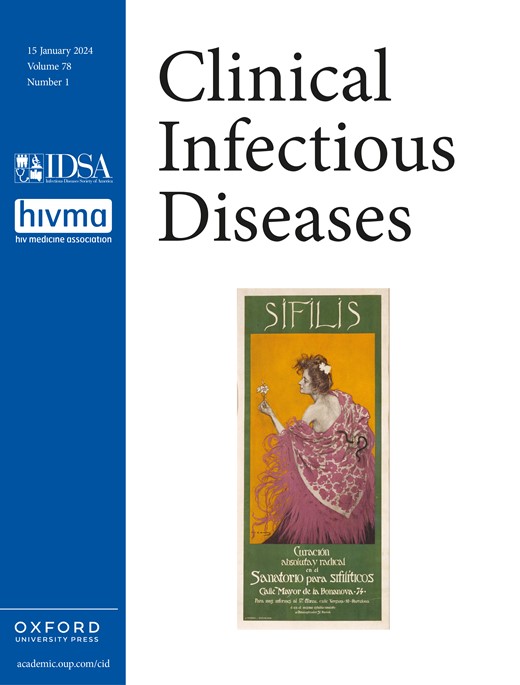Respiratory Syncytial Virus Co-Detection With Other Respiratory Viruses Is Not Significantly Associated With Worse Clinical Outcomes Among Children Aged <2 Years: New Vaccine Surveillance Network, 2016–2020
IF 8.2
1区 医学
Q1 IMMUNOLOGY
引用次数: 0
Abstract
Background Risk factors for severe respiratory syncytial virus (RSV) illness include early infancy, premature birth, and underlying medical conditions. However, the clinical significance of respiratory viral co-detection is unclear. We compared the clinical outcomes of young children with RSV-only detection and those with RSV viral co-detection. Methods We conducted active, population-based surveillance of children with medically attended fever or respiratory symptoms at 7 US medical centers (1 December 2016–31 March 2020). Demographic and clinical data were collected through parental interviews and chart abstractions. Nasal swabs, with or without throat swabs, were systematically tested for RSV and 6 other common respiratory virus groups. We compared clinical outcomes, including hospitalization, and among those hospitalized, length of stay, intensive care unit admission, supplemental oxygen use, and intubation, between children aged <2 years with RSV-only detection and those with RSV co-detection. Results We enrolled 18 008 children aged <2 years. Of 17 841 (99.1%) tested for RSV, 5099 (28.6%) were positive. RSV was singly detected in 3927 children (77.0%) and co-detected in 1172 (23.0%). RSV co-detection with parainfluenza virus or adenovirus was associated with significantly lower odds of hospitalization (adjusted odds ratio, 0.56; 95% confidence interval [CI]: .33–.95; P = .031) and supplemental oxygen use (adjusted odds ratio, 0.66; 95% CI: .46–.95; P = .026), respectively, than RSV-only detection. For all other comparisons, we did not identify a significant association between RSV co-detection and worse clinical outcomes. Conclusions Co-detection of RSV with another respiratory virus was not significantly associated with worse clinical outcomes compared with RSV-only detection.呼吸道合胞病毒与其他呼吸道病毒的联合检测与2岁以下儿童较差的临床结果无显著相关:2016-2020年新疫苗监测网络
背景:严重呼吸道合胞病毒(RSV)疾病的危险因素包括婴儿早期、早产和潜在的医疗条件。然而,呼吸道病毒联合检测的临床意义尚不清楚。我们比较了单纯检测RSV和同时检测RSV病毒的幼儿的临床结果。方法:我们在美国7个医疗中心(2016年12月1日至2020年3月31日)对有发热或呼吸道症状的儿童进行了积极的、基于人群的监测。通过父母访谈和图表抽象收集人口统计学和临床数据。对鼻拭子(含或不含咽拭子)进行了RSV和其他6种常见呼吸道病毒组的系统检测。我们比较了仅检测RSV和合并检测RSV的2岁儿童的临床结果,包括住院情况、住院时间、重症监护病房入住情况、补充氧气使用情况和插管情况。结果入组18 008名2岁儿童。在17841例(99.1%)RSV检测中,5099例(28.6%)呈阳性。RSV单检3927例(77.0%),共检1172例(23.0%)。RSV与副流感病毒或腺病毒共检与住院率显著降低相关(校正优势比为0.56;95%置信区间[CI]: 0.33 ~ 0.95;P = 0.031)和补充氧使用(校正优势比为0.66;95% ci: 0.46 - 0.95;P = 0.026),分别高于单纯rsv检测。对于所有其他比较,我们没有发现RSV联合检测与较差临床结果之间的显著关联。结论与单纯检测RSV相比,RSV与其他呼吸道病毒联合检测与临床结果无显著相关性。
本文章由计算机程序翻译,如有差异,请以英文原文为准。
求助全文
约1分钟内获得全文
求助全文
来源期刊

Clinical Infectious Diseases
医学-传染病学
CiteScore
25.00
自引率
2.50%
发文量
900
审稿时长
3 months
期刊介绍:
Clinical Infectious Diseases (CID) is dedicated to publishing original research, reviews, guidelines, and perspectives with the potential to reshape clinical practice, providing clinicians with valuable insights for patient care. CID comprehensively addresses the clinical presentation, diagnosis, treatment, and prevention of a wide spectrum of infectious diseases. The journal places a high priority on the assessment of current and innovative treatments, microbiology, immunology, and policies, ensuring relevance to patient care in its commitment to advancing the field of infectious diseases.
 求助内容:
求助内容: 应助结果提醒方式:
应助结果提醒方式:


